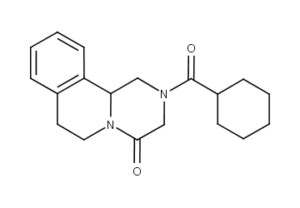Praziquantel CAS NO 55268-74-1 Inquire about Praziquantel
Tecoland supplies Praziquantel bulk active pharmaceutical ingredient (API) to the pharmaceutical industry. Our Praziquantel is manufactured by cGMP compliant facility. Welcome to contact us for further details including current DMF status for the product and up to date regulatory status of the manufacturing facility. We look forward to assisting you with your research and development projects.
What is Praziquantel?
Praziquantel (Biltricide) is an anthelmintic effective against flatworms. Praziquantel is not licensed for use in humans in the UK; it is, however, available as a veterinary anthelmintic, and is available for use in humans on a named-patient basis.
What is the mode of action?
Although the mode of action is not exactly known at present, there is experimental evidence that praziquantel increases the permeability of the membranes of schistosome cells towards calcium ions. The drug thereby induces contraction of the parasites, resulting in paralysis in the contracted state. The dying parasites are dislodged from their site of action in the host organism and may enter systemic circulation or may be destroyed by host immune reaction (phagocytosis). Additional mechanisms including focal disintegrations and disturbances of oviposition (laying of eggs) are seen in other types of sensitive parasites.
Another hypothesis concerning the mechanism of action of praziquantel has been recently reported. The drug seems to interfere with adenosine uptake in cultured worms. This effect may have therapeutical relevance given that the schistosome, as the taenia and the echinococcus (other praziquantel sensitive parasites), is unable to synthesize purines such as adenosine de novo.
Bayer’s Animal Health Division website states, “Praziquantel is active against cestodes (tapeworms). Praziquantel is absorbed, metabolized in the liver and excreted in the bile. Upon entering the digestive tract from the bile, cestocidal activity is exhibited. Following exposure to praziquantel, the tapeworm loses its ability to resist digestion by the mammalian host. Because of this, whole tapeworms, including the scolices, are very rarely passed after administration of praziquantel. In many instances only disintegrated and partially digested pieces of tapeworms will be seen in the stool. The majority of tapeworms are digested and are not found in the feces.”
What are the Side effects?
The majority of side effects develop due to the release of the contents of the parasites as they are killed and the consequent host immune reaction. The heavier the parasite burden, the heavier and more frequent the side effects normally are.
Central nervous system: Frequently occurring side effects are dizziness, headache, and malaise. Drowsiness, somnolence, fatigue, and vertigo have also been seen. Almost all patients with cerebral cysticercosis experience CNS side effects related to the cell-death of the parasites (headache, worsening of pre-existing neurological problems, seizures, arachnoiditis, and meningism). These side effects may be life-threatening and can be reduced by coadministration of corticosteroids. It is strongly recommended that all patients with cerebral cysticercosis are hospitalized during treatment.
GI Tract: Approximately 90% of all patients have abdominal pain or cramps with or without nausea and vomiting. Diarrhea may develop and may be severe with colic. Sweating, fever, and sometimes bloody stools may occur together with diarrhea.
Liver: Asymptomatic and transient increases of liver enzymes (AST and ALT) are noted frequently (up to 27%). No case of symptomatic liver damage has ever been seen so far.
Sensitivity reactions: Urticaria, rash, pruritus and eosinophilia in white blood cell counts
Other locations/body as a whole: Lower back pain, myalgia, arthralgia, fever, sweating, various cardiac arrhythmias, and hypotension.
How to dose Praziquantel?
For schistosomiasis, the dose is 20 milligrams/kilogram by mouth every 4¨C6 hours for one day. For tapeworms, the dose is 5¨C25 mg/kg by mouth once. For liver fluke, the dose is 25 mg/kg by mouth every 4¨C6 hours for one day. These dosages are for patients over 4 years old, and are to be taken with food or a few minutes before a meal.
Storage
Store praziquantel below 86 degrees F (30 degrees C). Store away from heat, moisture, and light. Do not store in the bathroom. Keep praziquantel out of the reach of children and away from pets.
Disclaimer:
Information on this page is provided for general information purposes. You should not make a clinical treatment decision based on information contained in this page without consulting other references including the package insert of the drug, textbooks and where relevant, expert opinion. We cannot be held responsible for any errors you make in administering drugs mentioned on this page, nor for use of any erroneous information contained on this page.